Mainstreaming at COP 13
At its thirteenth meeting, the Parties adopted a decision on the mainstreaming of biodiversity with a particular focus on the agriculture, forestry, fisheries and tourism sectors (decision XIII/3). The high-level Segment also adopted the Cancun Declaration on Mainstreaming the Conservation and Sustainable Use of Biodiversity for Well-Being.
Decision XIII/3 اللغة العربي |
English |
Español |
Français |
Pусский |
中文
Cancun Declaration اللغة العربي |
English |
Español |
Français |
Pусский |
中文
Mainstreaming at COP 14
In decision XIII/3, the Parties decided that at the fourteenth meeting of the Conference of the Parties (COP-14), they would consider the mainstreaming of biodiversity into the sectors of energy and mining, infrastructure, manufacturing and processing, as well as health.
Mainstreaming of biodiversity and other strategic actions to enhance implementation: request for submission of relevant information
Further to the
notification 2018-019 of 25 January 2018 seeking inputs for documentation being prepared for the second meeting of the Subsidiary Body on Implementation, to be held on 9-13 July 2018 in Montreal, Canada, on agenda item 5, on the topic of “Mainstreaming of biodiversity within and across sectors and other strategic actions to enhance implementation” the Secretariat received the following submissions:
Governments:
- Belgium
(Key words: health, green deal, infrastructure, mining) - Canada
(Key words: energy, renewable energy, mining, infrastructure, health, forestry) - European Union
(Key words: mining, renewable energy, infrastructure, energy, health, environmental impact assessment, environmental liability, industrial emissions and waste, company reporting, green environmental financing policies) - Germany (Submission 1, Submission 2)
(Key words: climate change, renewable energy, energy, agriculture, cities, health) - Iraq
(Key words: oil ) - Kenya
(Key words: mining and manufacturing, health, water, devolution and planning) - Madagascar
(Key words: mining, energy, infrastructure and public works, health) - Mexico
(Key words: manufacturing, mining, Agencia de seguridad, energia y ambiente (Regulator of the hydrocarbon sector) - The Netherlands
(Key words: environmental assessment, natural capital, health) - New Zealand
(Key words: mining) - Norway
(Key words: hydropower, principles, safeguards) - Sweden (Submission 1, Submission 2, Submission 3)
(Key words: mining) - United Kingdom of Great Britain and Northern Ireland
(Key words: energy and mining, infrastructure, manufacturing, health) - Venezuela
(Key words: tourism, water, agriculture, forestry and aquaculture, coastal zones)
Organizations:
Preparations
SBSTTA-21 Side Events
The Infrastructure Tsunami: Mainstreaming Biodiversity and Ecosystem Services for truly Sustainable Infrastructure (Event #2381, Room 518B)
The pace of global infrastructure development is accelerating, with investment expected to reach $90 trillion by 2030 – more than the entire stock of built infrastructure existing today. Can this be achieved without destroying our biological heritage? This event explored current approaches for mainstreaming biodiversity and ecosystem services in infrastructure - highlighting energy, mining and transport sectors. It focused on the critical ‘upstream’ phases where decisions made have the greatest ultimate influence on environmental outcomes. The session framed the scale and range of challenges that will be generated by this wave of new infrastructure to both ecosystems and socio-cultural aspirations. It catalyzed discussion on how to shift this wave’s trajectory toward real sustainability through better integration of biodiversity, ecosystem services and cultural objectives in planning and policy. Different case studies from different countries presented situations in which new infrastructures such as railways were profoundly damaging natural ecosystems, vital to many important species. These cases also displayed the lessons learned from infrastructure mistakes at the planning level and new mechanisms put in place in order to preserve these natural habitats. Experience is showing that if planned and designed well, a new era in infrastructure development will help rather than hinder the world’s ability to achieve the Aichi Targets, Sustainable Development Goals, and Paris Agreement commitments.
The discussion of this event highlighted the importance of ensuring accountability of export banks that finance the biggest of infrastructure. This is an idea that needs to be worked on, as it is a quite messy area. The discussion also underlined that important areas of conservation needed to be defined and the kind of advice Parties can practically apply to make things implementable to make sure these infrastructure developments are sustainable.
The Infrastructure Tsunami - Compiled presentations
Mainstreaming Biodiversity in the Manufacturing and Processing Sector (Event #2344, Room 520 B)
This side event started with a brief background of the relevance of the manufacturing and processing sector including that, by 2050 manufacturing will contribute 27.6 per cent of global GDP and 24.2 per cent of global employment. While the dependence on biodiversity may vary by business sector, the impacts, whether direct or indirect, are significant regardless. During this session, speakers of leading industries as well as NGOs and Governments were invited to talk about what they have done regarding the mainstreaming of biodiversity in the manufacturing and processing sector.
The Head of Sustainable Sourcing Innovation at KERING spoke about the French based luxury brand and its efforts on sustainability and biodiversity. Kering thinks of itself as an agriculture and mineral based company and wants to change its sourcing practice. Kering has a goal to half their environmental footprint by 2025 and to that end have developed an Environmental Profit and Loss tool which values the environmental impacts of a business across its entire supply chain.
Wildlife Habitat Council (WHC) then spoke about their experience working with companies on a range of projects related to mainstreaming biodiversity. They have a 3 pronged approach: firstly by working on projects on the ground, secondly by doing conservation verification and thirdly by communicating what companies are doing. WHC has worked with 100 companies helping to identify the business reasons to do natural resource conservation. The session carried on with a representative of the Gaborone Declaration for Sustainability in Africa and Conservation International, Japan presenting the work on launching a Natural Capital Coalition platform in Japan to facilitate dialogue and help raise awareness to Japanese businesses. The President of Biodiversity Partnership Mesoamerica, Costa Rica spoke about the biodiversity crisis and the need for better awareness of impacts on humanity. He identified 3 steps as to what businesses can do: 1) understand their effects and dependence on biodiversity 2) define opportunities to work on biodiversity and 3) plan and implement these opportunities. He stressed the need to look at facilities upstream and downstream; to look at the potential in innovation and product development and to involve employees in any actions and activities. The event finished with a discussion around measurement vs. variation. A lot of companies measure, but they don’t necessarily understand the importance of what they are measuring. The importance of biodiversity needs to be conveyed in a way that is better understood. The discussion then continued with an explanation of the Natural Capital Protocol and its potential to help improve decision making by recognising dependencies. The side-event closed with a series of comments and questions around the challenges to understand and track impacts and dependencies across a large supply chain. Another issue that was raised was that mainstreaming is only seen as philanthropic, there is a need for better language to communicate with businesses. Finally it was expressed that businesses are looking for better leadership on biodiversity.
Mainstreaming Biodiversity in the Manufacturing and Processing Sector - Presentation 1 Mainstreaming Biodiversity in the Manufacturing and Processing Sector - Presentation 2 Mainstreaming Biodiversity in the Manufacturing and Processing Sector - Presentation 3 Mainstreaming Biodiversity in the Manufacturing and Processing Sector - Presentation 4 Mainstreaming Biodiversity in the Manufacturing and Processing Sector - Presentation 5
Strategic Environmental Assessment: Mainstreaming Biodiversity in Mining, Energy and Infrastructure Sectors (Event #2353, Room 518C)
This event was hosted by the Netherlands Commission for Environmental Assessment (NCEA), an independent advisory body that supports governments on request with the introduction and development of SEA (Strategic Environmental Assessments). During this session, the NCEA shared its 25 years of SEA experiences and lessons learnt focusing on strategic planning in the mining, energy and infrastructure. SEA for mining, energy and infrastructure builds upon Decision VIII/28-2006 Voluntary Guidelines on Biodiversity-Inclusive Impact Assessment. After explaining the difference between EIAs – project planning - and SEAs –strategic planning complementing the EIAs-, the NCEA presented three case examples where SEAs were needed. The first case displayed the need of SEA for uranium mining in Namibia, the second case emphasized on the need of SEA in the infrastructure sector in the North-South corridor of the Greater Mekong subregion and the last case study was SEA for hydropower development in India for supporting better management and cumulative effects of dams. The three cases proved SEAs to be a success and have advantages to government project planning and society, such as helping the government being better prepared for new developments, support a better management of cumulative effects arising from planning decisions in the context of development in major sectors, know anxieties and aspirations of stakeholders and protect the weakest groups in society.
The discussion of this event revolved around the next steps that could be achieved to strengthen biodiversity-inclusive SEA that SBSTTA could recommend to COP. Some answers included the questions of how to ensure mechanisms when discussing about SEA, and the role of the CBD and SBSTTA in mainstreaming SEAs. Another important factor underlined was the question of the cost of SEA. One recommendation highlighted to strengthen biodiversity-inclusive SEA would be to collect as many case studies as possible and based on all of them lead an analysis and good practices that can then be shared: conferences on the topic should invite Parties to share what works and what does not.
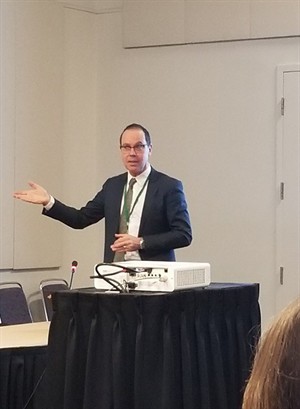
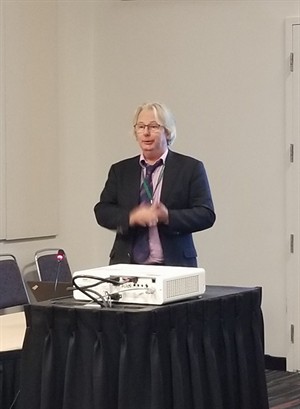 Strategic Environmental Assessments - Presentation 1 Strategic Environmental Assessments - Presentation 2 Leaflet - Infrastructure Leaflet - Hydropower Leaflet - Mining Leaflet - Spatial Planning
Strategic Environmental Assessments - Presentation 1 Strategic Environmental Assessments - Presentation 2 Leaflet - Infrastructure Leaflet - Hydropower Leaflet - Mining Leaflet - Spatial Planning
Strategies and Legal Tools for Mainstreaming Biodiversity and Human Rights in the Mining Sector (Event #2366, Room 520A)
Mining can have a significant impact on the health of ecosystems and people: for instance, the migration of pollutants from mining waste sites to nearby food cultivation areas rich in agrobiodiversity or downstream fishing grounds. These impacts can affect human rights such as the right to health, water and food. People, individually and collectively, can contribute to prevent and address the impacts of mining on life support systems through exercising human rights, such as the right to information, participation and access to justice. Therefore, it is especially important to mainstream biodiversity and human rights in the mining sector. Presenters highlighted that there is a need for a synergistic use of environmental laws and human rights for mainstreaming biodiversity in the mining sector. Some of the tools presented as potentially useful to asses mining activities are the Ecosystem and Well-being Framework, as well as the GOXI platform (www.goxi.org) which is a space for dialogue and a platform for innovation and collaboration serving those actively working on governance issues in the extractive industries. A third tool that was introduced was the Legal Assessment Tool (LAT) and its focus is to examine how the objectives of the CBD can be implemented through national legal frameworks to support conservation and sustainable use of biodiversity, through integration with human rights tools and biodiversity protection systems. The LAT, when administered in the various national contexts, supports a legal assessment of whether, and how governments are undertaking their integration of actions for conservation and sustainable use of biodiversity, into the human rights sector. Finally, other tools that were highlighted were community protocols and community paralegals. Community protocols are culturally rooted documents that embody the values, traditional knowledge, and culture of communities. They are important tools for dialogue, for consistency and transparency. The protocol should be owned by the community and should be a participatory process. Community paralegals are trained so that a community can be empowered to be able to collect its own data and document legally actionable evidence about impacts that mining activities could have on a particular community.
Value of Sustainable Infrastructure (Event #2349, Room 518 B)
Infrastructure is crucial for the attainment of the SDGs and is recognized as such in Goal 9 “Industry, Innovation and Infrastructure, Built resilient Infrastructure promote inclusive and sustainable industrialization and foster innovation”. This session conveyed the idea that no long-term development can be envisaged unless the diversity of natural habitats and ecosystems are systematically included in the development, industrial and innovation policies. Together with IISD, WWF presented the report “Biodiversity and Infrastructure: a better nexus” where some policy recommendations are made.
This session presented case studies where infrastructure was sustainably used through diverse projects in Montreal, Mongolia and Zambia. In Montreal, two appealing projects respectively named Biopolis and Bleu Montreal were presented by WWF Canada. The former project is a website aimed at informing inhabitants of North America what is currently happening in urban agriculture and biodiversity. More than 70 projects linked to urban biodiversity and posted on the website where people can also interact. This hub is a great way to mainstream biodiversity. The latter aims to re-open tunnels and rivers in order to create more water in the urban city of Montreal by daylighting rivers. The second case presented related to the mainstreaming of biodiversity through landscape-scale planning in Zambia and Mongolia, in the face of intense development pressure from the mining industry. It was interesting to understand how these two countries have been working with development plans to create more sustainable decisions. This event then touched on the solutions for financing infrastructure with the main challenge being that sustainable infrastructure takes more time and more money to deploy, with high upfront capital costs. Some solutions to take away the higher costs and push forward sustainable infrastructure would be to project preparation costs and capital costs. Another appealing solution that was presented was the Viability Gap Fund – a loan given to make economically and socially important projects financially viable targeted at sustainable infrastructure or nature-based infrastructure.
The discussion of this event highlighted shared experience from Singapore on sustainable infrastructure, practicing permaculture on sidewalks and connecting NGOs and community in biodiversity conservation. Latin-America also asked if daylight ravines could be happening in Latin America, considering that the scale of the rivers is not the same.
Value of Sustainable Infrastructure - Presentation 1 Value of Sustainable Infrastructure - Presentation 2
Mainstreaming Biodiversity into the Energy and Mining Sectors (Event #2371, room 518C)
Progress has been made regarding biodiversity and ecosystem management in the energy and mining sector, yet challenges remain to replicating and upscaling good practice. This side event organized by the UN Environment, the SCBD and UNEP-WCMC and hosted by IPIECA drew on expertise from within the industry, government and other groups to discuss some of these challenges and help identify opportunities for mainstreaming biodiversity into the energy and mining sectors. This session aimed to provide technical input into the agenda item on mainstreaming biodiversity into the energy and mining sectors that will be considered at the 14th meeting of the Conference of the Parties. The session took the form of a discussion that provided an opportunity for attendees to hear the perspectives of key stakeholders and present their own experiences of mainstreaming biodiversity into the energy and mining sector. The main point of the discussion stressed that in the last 15 years, developing countries have been more and more engaged in the energy, oil, gas and mining sectors. The discussion revolved around how could we do that while not compromising the SDGs? Key highlights of the discussion presented sustainable development infrastructure as a challenge and the ways in which that concept could become more realistic. Another challenge that was key to the discussion underlined the investments - energy and mining interventions – that will always have impacts on biodiversity, thus the question of thinking strategically where to invest to preserve biodiversity was raised. Another important point that was brought up is that when making new investments, costs of environment and biodiversity impacts are not always considered, thus the necessity to take action on that point when considering new projects. An interesting point raised by the Netherlands was the need to make sure all tools such as SEAs, special landscape approach etc. are on the table to make more well-informed decisions. Mexico highlighted the importance of establishing contact with academic institutions and work together to make positive change. At the end of this side event, a key point highlighted was that biodiversity does have a value and we need to put a value on it. To that end, regional development banks are critical as they are the ones mostly helping to implement such projects. The discussion ended on the question of is there such thing as sustainable infrastructure and the need to find ways to capitalize on social and environmental conscience of many businesses. This side event is part of an ongoing, consultative process on gathering perspectives from across the infrastructure and energy and mining sectors for consideration at SBSTTA-21 and beyond. As part of this project, the organizers will be arranging an expert meeting to gather stakeholder perspectives on mainstreaming biodiversity into the infrastructure sector in the spring of 2018.
Natural Systems for Sustainable Cities: Mainstreaming Biodiversity into Urban Infrastructure Development (Event #2378, Room 519A)
CBD COP14 will include a focus on mainstreaming biodiversity in infrastructure. The Cities and Biodiversity Outlook (2012) states that more than 60% of the area projected to be urban in 2030 has yet to be built. With 70% of projected infrastructure to be built in and around cities, the urban expansion from 2017 to 2030 has the potential to have a significant impact on globally important biodiversity areas. At the same time, cities are also uniquely positioned to make choices that contribute to the achievement of global, regional and national biodiversity and sustainable development commitments and targets. The projected urban expansion also provides an opportunity to design innovative and sustainable cities for the future, which better utilize and manage biodiversity and ecosystem services.
The side event showcased relevant and recent scientific findings, and discussed the project as well as other recent developments of relevance around biodiversity and sustainable cities. It also provided an opportunity to inform Parties and partners and discuss further collaboration on this topic. The CBD Secretariat, ICLEI, Future Earth, The Stockholm Resilience Centre, SwedBio and the Nature Conservancy (TNC) are cooperating on a project that has relevance for the mainstreaming issues to be considered by CoP14, particularly in relation to infrastructure. The project proposes to provide national, subnational and local governments with tools and effective practices to minimize impacts and protect ecosystem processes in urban development, planning and management in these priority areas. The project includes assessments, planning exercises, best practices, demonstrative pilot project and dissemination of results and lessons learned. Out of this project was highlighted that the majority of protected areas have been and will continue to be impacted by on biodiversity-rich ecosystems. The event presented two case study examples, one in the global north in Dortmund and one in the global south in Malawi, where the project has been implemented and lessons have been learnt. Overall, a lack of capacity and lack of dialogue was found in these cities and the importance of how we package biodiversity was highlighted. There is sometimes a misunderstanding of decision-makers because we fail to communicate well the benefits of/impacts on biodiversity? During the discussion of this event, some country representatives presented what their country did to preserve biodiversity in cities even if highly urbanized, such as in Singapore. The question to make those efforts of preservation in coastal cities was also raised.
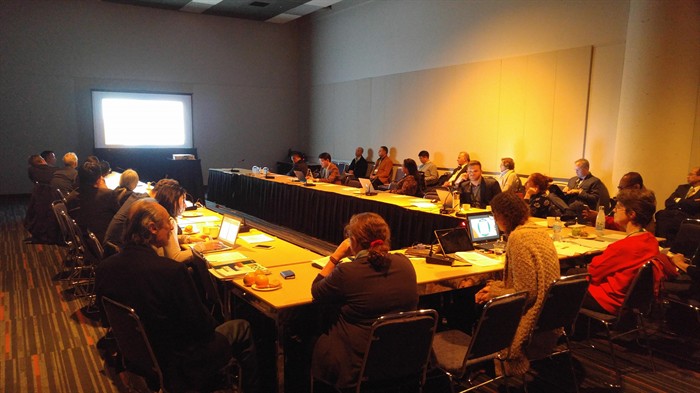
Please click
here for the presentation
Mainstreaming Biodiversity in Energy, Mining and Infrastructure across Conventions, Countries and Companies (Event #2365, Room 518 B)
Demand for energy and minerals are increasing globally (30% by 2040) with potential direct, indirect and cumulative impacts on biodiversity and ecosystem services. Most of this new energy will come from renewable sources and there are risks if this is not managed properly. During this session, NGOs and Governments were invited to talk about what they have done regarding the mainstreaming of biodiversity in energy, mining and infrastructure across conventions, countries and companies. The CMS Energy Task Force spoke of the need to scale up renewable energy while being aware of the risks from, for example of power lines and their impact on birds as well as wind turbines leading to species displacement or hydro projects disrupting water systems and affecting fish pathways. The goal of the CMS Energy Task Force is to avoid the impact of energy development on migratory species. Various activities have been undertaken including a global analysis of birds and bats however the business case needs to be established in order to have greater affect. South Africa, for example, is looking at the costs to utilities of birds colliding with power lines. This event underlined the crucial aspect of mainstreaming and the need to treat energy and biodiversity together, not as separate silos, but to take both into account when designing policy and legislation. Germany strives to have all their energy sourced from renewable by 2050. This will have an impact on species and needs proper planning. Germany passed a legislation changing the spatial planning law requiring to include nature conservation, impact and species as well as a shut down on demand for wind turbines to be taken into account in any planning. The session continued with the South African government explaining their initiatives on renewable energy and biodiversity. They have been working with BirdLife to conduct an impact analysis. They have also done mapping around sensitive areas and breeding sites and looked at all of the information available including bird flight paths, trends and barrier to movements. Eskom, South Arica electricity supplier and the Endangered Wildlife Trust (EWT) have formed a strategic partnership that goes beyond just mapping and includes identifying hot spots and what actions are required. The side-event then focused on some examples of collaboration between government and NGOs in Egypt. Egypt is at the heart of the migratory path for many bird species and is the second most important route. It is a critical site as the birds need to stick close by land masses as they migrate. Efforts have been undertaken to help mitigate the impacts on birds including cross-border collaboration. Baseline studies have been conducted and continued efforts on data collection. These efforts are happening at all levels and include training, providing guidelines on Environmental Impact Assessments and monitoring methodologies. This event stressed the fact that development is unavoidable, but that it should be sustainable development. At the next COP, hosted by Egypt, ministers from the other sectors including from the mainstreaming sectors of energy and mining, infrastructure, manufacturing and processing and health need to be at the table alongside the Ministers from the Environment. It is an opportunity to listen and educate.
The session closed with a series of questions and comments including on how to better imbed the CBD process with Egypt offering to invite the other ministries to the COP mentioned above. It was suggested that BirdLife could collect case studies like the one from Egypt and from other sectors and circulate them. There is a data collection center in Jordan with information and materials available. It was also suggested that the other biodiversity relate conventions could work more closely together as well as the possibility of the CBD sitting on the CMS Energy Task Force. The need to speak in “economic” terms was reinforced in order to get more buy-in and the possibility that bankers and investors should be included in discussions. The next Business Forum is an opportunity for this and the intention is to have more direct and greater business involvement in the upcoming Forum. Finally, the relevance of biomimicry in providing innovative energy solutions was mentioned as well as the need to include marine issues in all of the mainstreaming efforts.
The Importance of Subnational Governments for Mainstreaming Biodiversity into the Sectors of Energy and Mining, Infrastructure, Manufacturing and Processing Industry and Health (Event #2330, Room 518B)
The 20 Aichi Biodiversity Targets, which aim to orient a variety of stakeholders to the conservation and sustainable use of biodiversity, are very effective norms for the mainstreaming of biodiversity for all players and levels of government. This event showcased the efforts for mainstreaming biodiversity by the members of the Group of Leading Subnational Governments towards Aichi Biodiversity Targets (GoLS) and also their efforts to enlarge such policies. It also represented a good opportunity to discuss the role of subnational governments (SNGs) with some of the Parties and supporting organizations, such as the Network of Regional Governments for Sustainable Development (nrg4SD), International Council for Local Environmental Initiatives (ICLEI) and the Secretariat of the Convention on Biological Diversity (SCBD), and to clarify the importance of vertical alignment between Parties and SNGs. This event demonstrated that the members of GoLS commonly have been addressing most of the Aichi Targets with a variety of measures and have been mainstreaming biodiversity by generating concrete actions engaging many stakeholders of the societies. Nrg4SD, one of the supporting organizations of GoLS, launched a long-term project “Regions for Biodiversity Learning Platform” (R4BLP). This project has been carried out successfully with a number of members, providing good opportunities for deep exchange of specific subjects between subnational governments. These initiatives such as GoLS and nrg4SD, are leading to some developments like new methodology to conserve biodiversity or to engage people to it. Although promoting subnational actions is important, encouraging vertical collaboration among governments is essential in order to enhance the mainstreaming of biodiversity across the world. Most of the members of GoLS are collaborating with national governments by providing good practices or committing positively for the implementation of National Biodiversity Strategy and Action Plan (NBSAPs). ICLEI, another supporting organization of GoLS, just launched new “Guidelines on Subnational Implementation of NBSAPs”, based on many experiences of national, subnational and local collaborations. The main outcome of this meeting was to share the thought that horizontal collaborations among subnational governments and vertical collaboration among different levels of government should be enhanced and considered more, through the ongoing implementation and assessment of the Convention’s Strategic Plan, in order to achieve the Aichi Biodiversity Targets and the mainstreaming of biodiversity. During the discussion, subnational governments who were present such as Quebec highlighted the good work being done at the national level and more specifically at the regional level, and that new projects were developing.
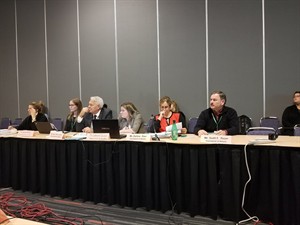
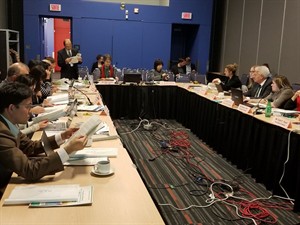
Conservation of Coastal Ecosystems and the Development of the Global Coastal Forum (Event #2384, Room 520C)
Coastal wetlands are of critical importance to the provision of many valuable ecosystem services, especially the sequestration of vast quantities of “blue carbon” and underpinning of economically important fisheries and shellfisheries. Coastal wetlands support diverse biological communities, including many of the world’s most threatened migratory species. Fragmented governance mechanisms at the regional, national and subnational level, including between separate bodies with responsibilities for terrestrial and marine systems, and between habitats and the wildlife they support, has led to coastal wetlands being overlooked and thus poorly protected around the world; meanwhile coastal ecosystems are increasingly imperiled by development, pollution, unsustainable fisheries and sea-level rise. Decisions such as CBD COP12 XII/9 in 2014 and Resolution XII.13 on Wetlands and disaster risk reduction for the Ramsar COP12 in Uruguay in 2015 have called for concerted action on the conservation and restoration of coastal wetlands. This side event encourages Parties to consider engaging in the development and implementation of the proposed initiative called “Caring for Coasts”. This event was hosted by CBD SBSTTA jointly with the Government of the Philippines, BirdLife International, Wetlands International and the East Asian-Australasian Flyway Partnership (EAAFP). The session started by highlighting why a global initiative for coastal wetland conservation and restoration was needed, due to coasts being profoundly damaged by human activity. An overview of global initiatives done so far for this purpose was presented, such as CBD COP12 in Pyeongchang, Ramsar COP12 in Uruguay and CMS COP12 in Manila. Some key deliverables for a worldwide initiative on coastal wetland restoration included an increased prioritization of coastal wetlands in global conservation as well as increased engagement with key stakeholders, including governments and private sectors. “Caring for Coasts” could help countries to preserve coastal wetlands by supporting the work of government and other stakeholders, including businesses. A presentation of the actions on coasts under the Ramsar Convention on wetlands and the specific instruments for contracting Parties was given.
The session closed with a series of questions and comments including if there were specific plans for people living in the mangrove areas: could they still make money by living in these damaged ecosystems? Comments from the Government of the Philippines were also made: they created a biodiversity programme in coastal areas under threat, regulating the fishing in some coastal areas. The government is already investing and has leveraged additional support from partners to fund coastal communities and provide them with some investment to start up. Comments from Egypt (Nature Conservation) included raising the concern that militarized countries where environment and sustainability is hard to attain as it is not their priority.
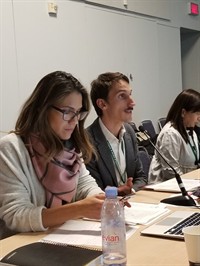
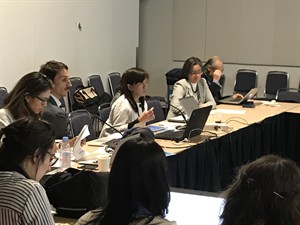 Conservation of Coastal Ecosystems - Presentation 1 Conservation of Coastal Ecosystems - Presentation 2
Conservation of Coastal Ecosystems - Presentation 1 Conservation of Coastal Ecosystems - Presentation 2